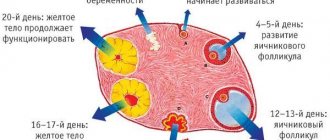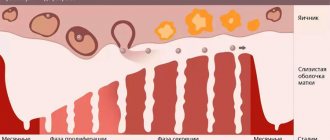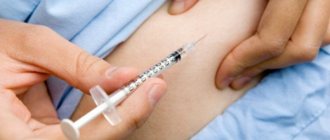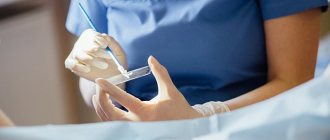For many women, late ovulation during a 28-day cycle becomes a serious cause for concern. After all, it is often not entirely clear whether this is a variant of the norm, and whether this process can prevent the desired pregnancy from occurring. To clarify doubts, it is worth finding out what the process of releasing an egg is, and whether its late occurrence can affect pregnancy planning.
Women's cycle
The female cycle lasts on average 28 days. The norm is considered to be from 21 to 35 days. When menstrual bleeding appears, the cycle is not established immediately, but after several months.
During the cycle, the body goes through several phases:
- Menstruation is the beginning of the cycle. The days are counted from the very first day of bleeding. This period lasts from 3 to 7 days. The most intense discharge occurs on days 2-3 of the cycle. During these days, the endometrium, which has formed over the past month, is rejected.
- The follicular phase begins after the end of menstruation. During this period, the dominant follicle is determined in which the egg will mature. The number of eggs in the body can reach 70 thousand, but 1 egg matures every month. Two or more eggs rarely mature.
- When the egg is released from the ovary, the ovulation phase begins. The lifespan of an egg is 24 hours. During this time, when a sperm is encountered, pregnancy occurs. The day of ovulation in a 28-day cycle occurs in the middle of the cycle, but can shift.
- If the fertilized egg is implanted in the uterine cavity, then intrauterine pregnancy has occurred.
- In the absence of fertilization, the body prepares for endometrial rejection and a new cycle.
Duration - features
Knowing the sequence of phases of the female cycle and methods for determining the day of ovulation, you can move on to the main question - how long does it last? In search of an answer to this question, women can find a lot of information, and not all of it is true. So, the statement that ovulation lasts 3-4 days is erroneous. In fact, the duration of ovulation is limited to shorter periods.
The ovulation process begins with the rupture of the follicle in the stigma area on its membrane. The exit occurs in a few minutes. Along with the rupture process, which may require additional time, it is generally accepted that the ovary ovulates within 1 hour. This is the maximum time during which the membrane ruptures and the egg and free fluid exit the vesicle into the abdominal cavity. This hour also includes the capture of the oocyte by the fallopian tube.
As for the ovulatory period, it is limited by the lifespan of the egg. According to various sources, a mature oocyte lives after release from 24 to 36 hours. Most often - a day. Rarely - 36 hours or less than a day. During this time, the reproductive cell is either fertilized or dies.
Upon fertilization, the zygote stage begins, and the embryo travels to the uterine cavity through the fallopian tubes to be implanted into the uterine wall approximately 7-8 days after ovulation. If within 24-36 hours the oocyte does not come into contact with a sperm that is active and mobile, capable of fusion and exchange of DNA information, pregnancy does not occur. The dead egg is again released into the uterine cavity, where it floats freely until the hormonal levels change, and then leaves it along with endometrial particles and menstrual bleeding.
Conclusion: ovulation lasts no more than an hour, and the ovulation period lasts about a day (24-36 hours). There can be no other options. Although some sources claim that an egg can live longer, this has not been proven by science and medicine.
Theoretically, a woman’s bad habits, violation of the rules of a healthy lifestyle, genetic predisposition, excess weight, and some diseases of the reproductive system can shorten the lifespan of an egg. In this case, the quality of the oocyte usually suffers, and conception does not always occur, even if the egg meets the sperm.
Normal menstrual cycle
A normal menstrual cycle lasts on average 28 days. If the deviation from the norm is more than 7 days, you should consult a gynecologist. Ovulation in a 28-day cycle occurs on the 14th day. The shorter the cycle, the faster ovulation occurs.
In young girls, during the first year after the start of menstruation, the duration of the cycle may change. In women whose bleeding begins every time after a certain number of days, the cycle is disrupted for several reasons:
- changing of the living place;
- climate change;
- diseases;
- stress;
- excessive physical activity;
- taking hormonal or other medications.
How to calculate ovulation
Gynecologists use a formula to calculate ovulation. Subtract 14 days from the length of the cycle. This method indicates the approximate day the egg is released and helps determine the days on which additional methods should be used to determine the favorable day of conception.
If a girl does not know when ovulation occurs in a 28-day cycle, then the formula should be applied: 28-14=14. Therefore, ovulation will occur on the 14th day of the cycle. The error of this method is 2 days. Consequently, ovulation occurs from the 12th to the 16th day of the cycle. In women with a short cycle, favorable days for conception may occur immediately after the end of menstruation.
If the cycle is not constant and the period varies slightly, then the average for the last six months is taken as the cycle length. This will help you find out the approximate days of ovulation and use additional methods.
Determining ovulation by sensations
You can determine the onset of ovulation if you listen to your feelings. Ovulation in a 28-day cycle occurs on the 12-16th day. Signs that indicate ovulation has occurred:
- Copious vaginal discharge. The secretion becomes viscous and resembles the white of a raw egg.
- A nagging pain appears in the abdomen. Mucus appears due to the rupture of the follicle and the release of the egg.
- Bloody issues. They are insignificant, sometimes the mucus turns pink. This symptom occurs in 20% of women.
- Chest pain, excessive nipple sensitivity.
- Increased sexual desire. Nature has provided for a woman’s desire to have sexual intercourse for procreation. Another reason may be a woman’s desire not to miss favorable days for conception.
- Changes in taste and smell.
Basal temperature
To determine the timing of ovulation in a 28-day cycle, basal temperature should be measured. To find out the normal temperature for the body, it is necessary to take measurements a few days before ovulation. To ensure the reliability of the result, manipulations should be carried out in the morning, after waking up, at the same time, without getting out of bed. The thermometer is inserted to a depth of 4-5 cm.
When plotting a graph, it will become clear that before ovulation the temperature drops and then rises. Ovulation will occur between a decrease and an increase in temperature. This way you can find out the exact day for conception.
The data should be plotted on a graph and connected with lines. The benefits of the drawing will appear after a few months, when it will be possible to determine the day of ovulation. The graph is a clear example of temperature changes and shows that on certain days of the cycle there is a sharp jump. This method is time consuming but accurate.
How many days does ovulation last?
Ovulation lasts only 12–48 hours. At the same time, most experts believe that the egg retains the ability to fertilize within 24 hours.
A woman who is trying to get pregnant should know that conception can and should be planned not only on the day of ovulation, but also several days before it occurs. The egg retains the ability to fertilize for a fairly short period - no longer than 1-2 days, and in some, no more than 12 hours, but sperm have a much longer lifespan.
Male cells are able to perform their functions even a few days after sexual intercourse. It is believed that the maximum viability of sperm is 7 days. Therefore, attempts to conceive a child can begin a week before the expected date of ovulation.
It should also be taken into account that sperm require a certain time to reach the egg. The speed of their movement is very low, and on average this process takes at least a day. So if sexual intercourse occurs directly on the day of ovulation, sperm may be “late,” that is, reach the location of the egg at a time when it is no longer capable of fertilization.
Taking into account all these features, you can significantly increase the likelihood of pregnancy and successfully conceive a child, spending a minimum amount of time.
Tests and ultrasound for ovulation
To determine favorable days for conception, ovulation tests are sold in pharmacies without a prescription. There are 5 pieces in one package, enough for a cycle. They are similar in use to pregnancy tests and react to the appearance of LH hormone in the urine. To determine the date of ovulation in a 28-day cycle, you should start using the test on the 10th day of the cycle. An increase in the amount of the hormone is indicated by the darkening of the second strip of the test. Thus, at home you can calculate the most favorable days for conception.
Another way to determine when ovulation occurs in a 28-day cycle is ultrasound. The examination begins on the 10th day of the cycle. On the 12th day, the growth of the corpus luteum is determined. On the 14th day, they find out whether ovulation has occurred or not. An additional study is prescribed on the 17th day to confirm the release of the egg. The doctor determines the condition of the ovaries in three ways:
- Transvaginally. The doctor determines what happens to the follicles through the vagina. No special preparation is required for this procedure, but it is better to cleanse the intestines first.
- Transabdominal. External ultrasound, which shows the degree of follicle maturation. You should drink liquid before the procedure, since the test is performed on a full bladder. In terms of the reliability of the result, this method is inferior compared to the first.
- Transrectal. Research is rarely used. Causes discomfort.
Causes of failure to ovulate
Ovulation in a 28-day cycle occurs on the 14th day, but sometimes the process occurs earlier or later. If the failure occurs once, the cause may be a cold, stress, heavy physical activity, or the consequences of an abortion. A permanent shift in ovulation is caused by:
- hormonal disorders;
- functional failure of target cells;
- disruption of the endocrine system;
- ovarian depletion;
- lack of sensitivity of ovarian receptors to hormonal molecules;
- polycystic ovary syndrome;
- operations of the uterine cavity or ovaries;
- inflammatory processes of the reproductive system;
- endometriosis;
- a brain tumor;
- hyperfunction of the thyroid gland;
- decrease in sex hormones;
- genetic predisposition;
- taking hormonal and steroid drugs.
The need to seek medical help
This does not pose any threat to the female body. Although there is no danger, it may indicate:
- About ovarian disease.
- About disorders in the endocrine system.
- About premature menopause.
- About diseases of the pituitary gland and hypothalamus.
These are very serious conditions that cause disruption of the menstrual cycle. They interfere with the production of active substances and break their biochemical connections, which provokes a malfunction of the woman’s reproductive system.
Reference! If early ovulation occurs constantly, then this threatens infertility if treatment is ignored.
If the main reason is a malfunction of the body, then you need to consult a doctor, since these conditions have dangerous consequences. In the field of gynecology, there are already ways to treat this dysfunction, so timely treatment will ensure a complete recovery.
Signs of late ovulation
The main sign of late ovulation in a 28-day cycle is the absence of symptoms from the 12th to the 16th day. If during this period there is no change in basal temperature, no discomfort in the lower abdomen, or increased breast sensitivity, then an ovulation test should be done to understand the changes occurring in the body.
You can find out what caused late ovulation together with a gynecologist. This may be a variant of the norm or a malfunction of the body. To find out, you should visit a gynecologist, take blood and urine tests and undergo an ultrasound.
If the cause of late ovulation is a recent abortion or pregnancy, then after a short period of time the cycle will be restored. The decision to take medications to restore your cycle should be made by your doctor.
How to define “these days”
You can calculate on what day ovulation occurs in a 28-day (or 30-day) cycle using ovulation detection methods. These include:
- Ultrasound of follicles;
- blood test to determine the concentration of luteinizing hormone (ovulation hormone);
- maintaining a basal temperature chart;
- ovulation test.
Every woman can independently calculate ovulation at home by measuring her basal temperature daily or using a test. Test diagnostics are done repeatedly, starting from about 11-12 days of the cycle. The mechanism of action of the test is simple: the reagent applied to the strip strip is sensitive to luteinizing hormone, which controls the release of the egg.
On the eve of ovulation, the test shows clear 2 stripes. On average, on the fourteenth day of the cycle, the test will show a positive result - this means that you cannot waste precious time: the egg lives for about a day or two! And if you miss the opportunity, you will have to wait at least another month for the favorable moment.
Keeping a temperature chart and buying tests - all this requires a certain discipline and financial investment. Or you can simply calculate the day of ovulation, knowing the start date of your last menstruation. How to do it?











